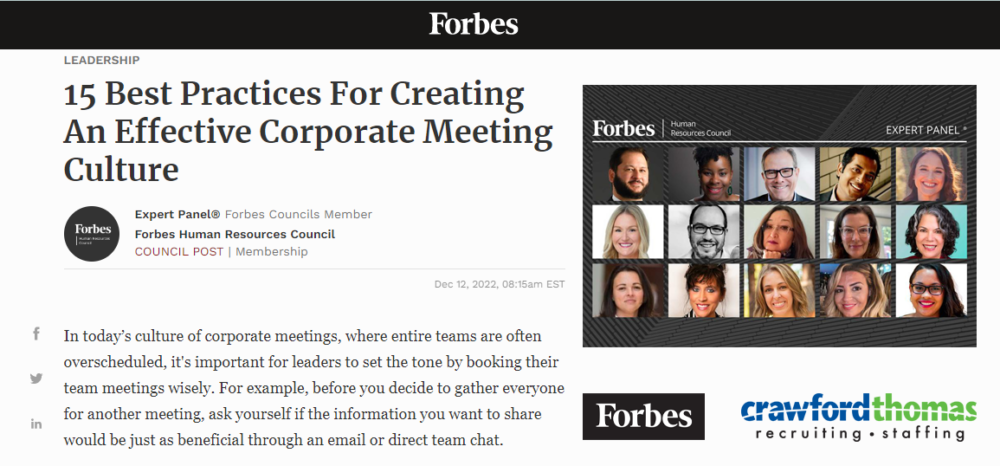
In today’s culture of corporate meetings, where entire teams are often over scheduled, it’s important for leaders to set the tone by booking their team meetings wisely. For example, before you decide to gather everyone for another meeting, ask yourself if the information you want to share would be just as beneficial through an email or direct team chat.
If the answer is yes, you’re one step closer to helping your company and its leadership team find a better balance between its meeting culture and being effective. Below, 15 Forbes Human Resources Council members discuss some of their best practices for other leaders to implement and make changes to how they handle meetings.

1. Share Team Updates Via Email
Meetings should only be held if they are necessary. Too many employees feel that time is wasted by sharing information in meetings that could have been shared through email updates instead. This makes it hard for them to accomplish the things they need to get done. The discretionary scheduling of meetings is paramount. – William Stonehouse, Crawford Thomas Recruiting
2. Schedule Time Blocks To Focus On Tasks And Training
We have weekly no-meeting days. For example, our fully remote staff has “No Meeting Day” Fridays and our hybrid staff has “Administrative Day” on Mondays. We’ve also suspended them during weeks with company holidays because the shorter weeks were creating more intense meeting days. Our staff has shared with leadership that having these days allows them to catch up on their deliverables and action items from the week and focus on training activities. – Tina Enagbare, Peer Health Exchange
3. Conduct Standing-Only Meetings
Whether it’s a remote meeting, an in-person meeting or a hybrid of both, ask people to stand for the entire meeting. You’ll be surprised how quickly the number of scheduled meetings drops. – Richard Polak, American Benefits Council
4. Follow Through On Action Plans
Meetings should always have an agenda and should end with action items or decisions. Any meeting without a clear agenda and plan of action should be considered an ineffective meeting. – Srikant Chellappa, Engagedly
5. Require Constructive Feedback From All Attendees
Because communication tools have advanced dramatically for more than the last three decades, meetings must be less about sharing information and more about creating synergy, cultivating connection and facilitating collaboration. At meetings, employees should be expected to actively participate by providing ideas and constructive feedback as well as asking questions. Employees who work on complex problems together maximize results. – Niki Ramirez, HRAnswers.org

6. Implement ‘Heads-Down Days’ Prior To Holidays And Long Weekends
Companies can help employees limit meetings by creating “heads-down days” before holidays or long weekends. These no-meeting days should be observed by the entire company. The goal is to ensure that employees complete projects so that their time off is not spent catching up on work. A heads-down policy can remind employees of the value of blocking off uninterrupted time to complete work. – Leigh Yanocha, Knopman Marks Financial Training
7. Be Flexible With Your Meeting Dates
Consistently audit the cadence of your meetings. Is meeting with your leadership team weekly any more productive than meeting biweekly? Priorities and workflows can change often, so audit your needs and make the pertinent cadence changes. – Joshua Siler, HiringThing
8. Audit The Effectiveness Of Each Meeting
An effective meeting means there are positive behavioral indicators from the participants. Unsuccessful meetings can be powerful if an analysis of what went wrong is conducted. The agenda should be business-specific and the diverse set of skills of attendees must be supported. Ideally, meeting culture should reflect the company’s values. – Nara Ringrose, Aquila Nuclear Engineering

9. Find Ways To Support Asynchronous Communication
To create balance, companies can look at how they can support asynchronous communication. Aligning teams around communication expectations is key. Every discussion does not need to happen as part of a formal meeting, so it’s important that employees are able to communicate questions and find answers through other channels like Slack, project management tools or the company intranet. – Leah Sutton, Elastic
10. Assign A Scribe To Report Meeting Highlights
Too often, people attend meetings out of habit or simply because they are on the team. If they are not vital to the conversation, they should not attend the meeting. Assigning an individual to provide a summary of the meeting and any decisions made can be one way to inform people who were not central to the discussion. – Edie Goldberg, E. L. Goldberg & Associates
11. Assess Your Time Loss
Google Calendar’s Time Insights feature often reminds me of how too many hours are spent in meetings, some of which could have been avoided by better asynchronous work routines. While meeting face-to-face over Zoom has the benefits of stimulating conversations, many companies could do a better job of reducing the number and length of meetings through better decision-making processes, documentation and meeting-free days. – Catalina Schveninger, DataCamp
12. Clearly Communicate The Agenda
Balancing meeting culture can be tricky but tactful. To help teams stay focused and be more efficient, leaders should always provide an agenda, sticking to clear start and end times for meeting dates and communicating expectations ahead of time. Preparing a report for an upcoming meeting enables employees to optimize the time spent in meetings, leading to fewer meetings and more respect for everyone involved when meetings are needed. – Noelle Federico, Delta Hire

13. Schedule Fewer Meetings And Adjust As Needed
Balancing just the right number of meetings within an organization can be tricky, but it’s usually better to err on the side of too few rather than too many. Meetings can stifle creativity and productivity, especially when there’s too much discussion and not enough action being taken to produce results. Managers should increase the number of meetings only as it makes sense for collaboration and efficiency. – Laura Spawn, Virtual Vocations, Inc.
14. Apply The WHAM Method
Eliminate meetings that should really just be email communications. I recommend that company leaders assess their need to schedule meetings through the WHAM method, That is, why have a meeting? Does your thought or idea require collaboration, brainstorming or input from others? Do you expect a lot of back-and-forth questions? Do you have an agenda? If you cannot answer yes to every question, your communication should be done through email. – JacLyn Pagnotta, Allied Partners
15. Be On Time, Efficient And Get To The Point
Leverage asynchronous work to eliminate unnecessary meetings. When meetings are necessary, be on time, be efficient and cut it short when possible. In global and remote workplaces, it is also important to consider time zone differences and respect the boundaries of blocked calendars. The core of a healthy meeting culture should be focused on consideration of other people’s time, consent and respect. – Cynamon Voe Scott, DuploCloud Inc.
About Crawford Thomas Recruiting:
Crawford Thomas is a team of leading HR recruiters. We not only fill staffing needs, we partner with organizations to find out how their recruiting needs tie into their business objectives. Through this, we are able to meet your staffing needs in a way that achieves organizational success.
Start securing top talent by visiting our page for employers today.

